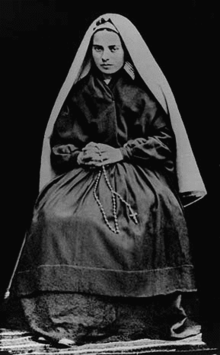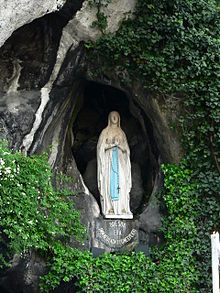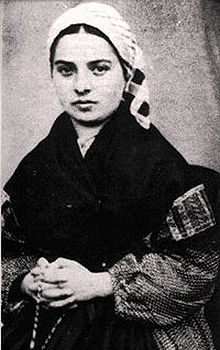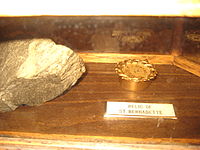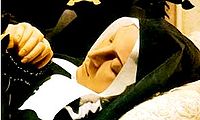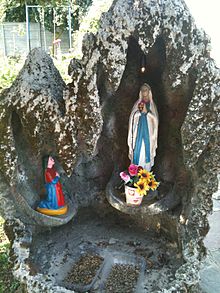- Bernadette Soubirous
-
Saint Bernadette Soubirous 
Saint Bernadette of LourdesBorn 7 January 1844[1]
Lourdes, FranceDied 16 April 1879 (aged 35)
Nevers, FranceHonored in Roman Catholicism Beatified 14 June 1927, Rome, by Pope Pius XI Canonized 8 December 1933, Rome, by Pope Pius XI Feast 16 April (18 February in France) Patronage Bodily illness Saint Marie-Bernarde Soubirous (7 January 1844 – 16 April 1879) was a miller's daughter born in Lourdes. From 11 February to 16 July 1858, she reported 18 apparitions of "a small young lady" who asked for a chapel to be built at that site at Lourdes.[2]
Despite initial scepticism from the Catholic Church, these claims were eventually declared to be worthy of belief after a canonical investigation, and the apparition is known as Our Lady of Lourdes. Since her death, Bernadette's body has apparently remained internally incorrupt, but her body is not without blemish; during her third exhumation in 1925, the firm of Pierre Imans made light wax coverings for her face and her hands due to the discoloration that her skin has undergone. These masks were placed on her face and hands before she was moved to her crystal reliquary in June of 1925. [3][4]
The shrine at Lourdes went on to become a major site for pilgrimage, attracting over five million Christian pilgrims of all denominations each year.[5]
On 8 December 1933, she was canonized as a saint by the Catholic Church; her Feast Day is celebrated on 16 April. She is considered a Christian mystic.
Contents
Early stages in her life
Bernadette (the sobriquet by which she was universally known) was the daughter of François Soubirous (1807–1871), a miller, and his wife Louise (née Castérot) (1825–1866), a laundress, and was the eldest of five children who survived infancy. Louise actually gave birth to nine children (Bernadette, Jean born and died 1845, Toinette 1846-1892, Jean-Marie 1848–1851, Jean-Marie 1851-1919, Justin 1855–1865, Pierre 1859-1931, Jean born and died 1864, and a baby girl named Louise who died soon after her birth 1866). Bernadette was born on 7 January 1844, and baptized at the local parish church, St. Pierre's, on 9 January, her parents' wedding anniversary. Bernadette's godmother was Bernarde Casterot, her mother's sister, a moderately well-off widow who owned a tavern. Hard times had fallen on France and the family lived in extreme poverty. According to one source neighbours reported that the family lived in unusual harmony, apparently relying on their love and support for one another and their religious devotion. Bernadette contracted cholera as a toddler and suffered severe asthma for the rest of her life. A different source suggests that the family routinely abused alcohol and some were even alcoholics. [6]
Visions
Main article: Lourdes apparitionsBy the time Bernadette received her visions, her family's financial and social status had declined to the point where they lived in a one-room basement, called le cachot, "the dungeon," where they were housed for free by her mother's cousin, Andre Sajoux.[7] On 11 February 1858, Bernadette, then aged 14, was out gathering firewood and bones with her sister Marie and a friend at the grotto of Massabielle outside Lourdes, and had her first vision. As she recounted later, while the other girls crossed the little stream in front of the grotto and walked on, Bernadette stayed behind, looking for a place to cross where she wouldn't get her stockings wet. She finally sat down in the grotto to take her shoes off in order to cross the water, and was lowering her first stocking when she heard the sound of rushing wind, but nothing moved. A wild rose in a natural niche in the grotto, however, did move; from the niche, or rather the dark alcove behind it, "came a dazzling light, and a white figure." This was the first of 18 visions of what she referred to as aquero (IPA: [aˈk(e)rɔ]), Gascon Occitan for "that". In later testimony, she called it "a small young lady" (uo petito damizelo). Her sister and her friend stated that they had seen nothing.[8]
On 14 February, after Sunday mass, Bernadette, with her sister Marie and some other girls, returned to the grotto. Bernadette knelt down immediately, saying she saw aquero again and falling into a trance. When one of the girls threw holy water at the niche, and another threw a rock from above that shattered on the ground, the apparition disappeared. Bernadette fell into a state of shock, and the girl who had thrown the rock actually thought she had killed her.[9] On her next visit, 18 February, she said that "the vision" asked her to return to the grotto every day for a fortnight.[10]
This period of almost daily visions came to be known as la Quinzaine sacrée, "holy fortnight." Initially, her parents, and especially her mother, were embarrassed and tried to forbid her to go; the local police commissioner called her into his office and threatened to arrest her,[11] as did the district attorney, but since there was no evidence of fraud there was little they could do.[12] The girl herself remained stubbornly calm and consistent during her interrogations, never changing her story or her attitude, and never claiming knowledge beyond what she said the vision told her.[13] The supposed apparition did not identify herself until the seventeenth vision, although the townspeople who believed she was telling the truth assumed she saw the Virgin Mary. Bernadette never claimed it to be Mary, consistently using the word aquero. She described the lady as wearing a white veil, a blue girdle, and with a yellow rose on each foot — compatible with "a description of any statue of the Virgin in a village church".[14]
Bernadette's story caused a sensation with the townspeople, who were divided in their opinions on whether or not Bernadette was telling the truth. Some believed her to have a mental illness, and demanded she be put in an asylum. She soon had a large number of people following her on her daily journey, some out of curiosity and others who firmly believed that they were witnessing a miracle.
The other contents of Bernadette's reported visions were simple, and focused on the need for prayer and penance — on 24 February, she reported that aquero had said Penitenço ... Penitenço ... Penitenço ("penance").[15] That day, Bernadette kissed the muddy ground of the grotto; the next day, she went further, and during her trance chewed and ate grass she plucked from the ground, rubbed mud over her face, and actually swallowed some mud, to the disgust of the many onlookers and the embarrassment of those who believed in her visions. She explained that the vision had told her "to drink of the water of the spring, to wash in it and to eat the herb that grew there," as an act of penance. To everyone's surprise, the next day the grotto was no longer muddy but clear water flowed.[16]
At the thirteenth of the alleged apparitions, on 2 March, Bernadette told her family that the lady had said "Please go to the priests and tell them that a chapel is to be built here. Let processions come hither." Accompanied by two of her aunts, Bernadette duly went to parish priest Father Dominique Peyramale with the request. A brilliant but often roughspoken man with little belief in claims of visions and miracles, Peyramale told Bernadette that the lady must identify herself. Bernadette said that on her next visitation she repeated the priest's words to the lady, but that the lady bowed a little, smiled, and said nothing. Then Father Peyramale told Bernadette to prove that the lady was real (that is, objectively) by asking her to perform a miracle. He requested that she make the rose bush beneath the niche where she appeared to Bernadette bud and flower on the last week of February.
As Bernadette later reported to her family and to church and civil investigators, at the ninth visitation the lady told Bernadette to drink from the spring that flowed under the rock, and eat the plants that grew freely there. Although there was no known spring, and the ground was muddy, Bernadette saw the lady pointing with her finger to the spot, and said later she assumed the lady meant that the spring was underground. She did as she was told by first digging a muddy patch with her bare hands and then attempting to drink the brackish drops.[17] She tried three times, failing each time. On the fourth try, the droplets were clearer and she drank them. She then ate some of the plants. When finally she turned to the crowd, her face was smeared with mud and no spring had been revealed. Understandably, this caused much skepticism among onlookers who shouted, "She's a fraud!" or "She's insane!" while embarrassed relatives wiped the adolescent's face clean with a handkerchief. In the next few days, however, a spring apparently began to flow from the muddy patch first dug by Bernadette. There is also a suggestion that the spring had been there previously. [18] Some devout people followed her example by drinking and washing in the water, which was soon reported to have healing properties.
In the 150 years since Bernadette dug up the spring, 67 cures have been verified by the Lourdes Medical Bureau as "inexplicable", but only after what the Church claims are "extremely rigorous scientific and medical examinations" that failed to find any other explanation. The Lourdes Commission that examined Bernadette after the visions also ran an intensive analysis on the water and found that, while it had a high mineral content, it contained nothing out of the ordinary that would account for the cures attributed to it. Bernadette herself said that it was faith and prayer that cured the sick.
Her 16th claimed vision, which she stated went on for over an hour, was on 25 March. During this vision, the second of two "miracles of the candle" is reported to have occurred. Bernadette was holding a lighted candle; during the vision it burned down, and the flame was said to be in direct contact with her skin for over fifteen minutes, but she apparently showed no sign of experiencing any pain or injury. This was said to be witnessed by many people present, including the town physician, Dr. Pierre Romaine Dozous, who timed and later documented it. According to his report, there was no sign that her skin was in any way affected, so he monitored Bernadette closely but did not intervene. After her "vision" ended, the doctor said that he examined her hand but found no evidence of any burning, and that she was completely unaware of what had been happening. The doctor then said that he briefly applied a lighted candle to her hand, and she reacted immediately. It is unclear if observers other than Dozous were sufficiently close to witness if the candle was continuously in contact with Bernadette’s skin.
According to Bernadette's account, during that same visitation that she claimed, she again asked the woman her name but the lady just smiled back. She repeated the question three more times and finally heard the lady say, in Gascon Occitan, "I am the Immaculate Conception" (Qué soï era immaculado councepcioũ, a phonetic transcription of Que soi era immaculada concepcion). Four years earlier, Pope Pius IX had defined the dogma of the Immaculate Conception; that, alone of all human beings who have ever lived (save for Jesus, Adam, and Eve), the Virgin Mary was conceived without the stain of original sin. Her parents, teachers, and priests all later testified that she had never previously heard the expression 'immaculate conception' from them.
Bernadette was a sickly child; she had cholera in infancy and suffered most of her life from asthma, and some of the people who interviewed her following her revelation of the visions thought her simple-minded. However, despite being rigorously interviewed by officials of both the Catholic Church and the French government, she stuck consistently to her story. Her behavior during this period is said to set the example by which all who have claimed visions and mystical experiences are now judged by Church authorities.
Results of her visions
Among the reported visions of Jesus and Mary, the impact of her visions can be viewed as being proportionally of a high level of significance.
Her request to the local priest to build a chapel at the site of her visions eventually gave rise to a number of chapels and churches at Lourdes. The Sanctuary of Our Lady of Lourdes is now one of the major Catholic pilgrimage sites in the world. One of the churches built at the site, the Basilica of St. Pius X, can itself accommodate 25,000 people and was dedicated by the future Pope John XXIII when he was the Papal Nuncio to France.
Close to 5 million pilgrims visit Lourdes (population of about 15,000) every year, with individuals and groups (such as the HCPT) coming from all over the world. Within France, only Paris has more hotels than Lourdes. In 2008, the 150th anniversary of the 1858 apparitions to Bernadette, it was expected that 8 million pilgrims would visit Lourdes during the year. Lourdes is now a major center where Catholic pilgrims from around the globe reaffirm their beliefs as they visit the sanctuary.
Later years
Disliking the attention she was attracting, Bernadette went to the hospice school run by the Sisters of Charity of Nevers, where she finally learned to read and write. She then joined the Sisters at their motherhouse at Nevers at the age of 22. She spent the rest of her brief life there, working as an assistant in the infirmary and later as a sacristan, creating beautiful embroidery for altar cloths and vestments. She later contracted tuberculosis of the bone in the right knee. She had followed the development of Lourdes as a pilgrimage shrine while she still lived at Lourdes, but was not present for the consecration of the Basilica of the Immaculate Conception there in 1876. She eventually died of her long-term illness at the age of 35 on 16 April 1879, and her body is laid to rest in the Saint Gildard Convent.
Sainthood
Bernadette Soubirous was declared venerable by Pope Pius X.
She was declared "Blessed" on June 2, 1925, by Pope Pius XI.
She was officially canonized a Saint by Pope Pius XI on December 8, 1933.
The year 2009 was declared "The Year of Bernadette".
Exhumations
Bishop Gauthey of Nevers and the Church exhumed the body of Bernadette Soubirous on 22 September 1909, in the presence of representatives appointed by the postulators of the cause, two doctors, and a sister of the community. They claimed that although the crucifix in her hand and the rosary had both oxidized, her body appeared "incorrupt" — preserved from decomposition. This was cited as one of the miracles to support her canonization. They washed and reclothed her body before burial in a new double casket. The Church exhumed the corpse a second time on 3 April 1919. A doctor who examined the body noted, "The body is practically mummified, covered with patches of mildew and quite a notable layer of salts, which appear to be calcium salts. ... The skin has disappeared in some places, but it is still present on most parts of the body."[19]
In 1925, the church exhumed the body for a third time. They took relics, which were sent to Rome. A precise imprint of the face was molded so that the firm of Pierre Imans in Paris could make a wax mask based on the imprints and on some genuine photos. This was common practice for relics in France, as it was feared that the blackish tinge to the face and the sunken eyes and nose would make an unpleasant impression on the public. Imprints of the hands were also taken for the presentation of the body and the making of wax casts. The remains were then placed in a gold and crystal reliquary in the Chapel of Saint Bernadette at the mother house in Nevers. The site is visited by many pilgrims and the body of Saint Bernadette is still shown despite being nearly 130 years old.[20][unreliable source?]
Three years later in 1928, Doctor Comte published a report on the exhumation of the Blessed Bernadette in the second issue of the Bulletin de I'Association medicale de Notre-Dame de Lourdes.
"I would have liked to open the left side of the thorax to take the ribs as relics and then remove the heart which I am certain must have survived. However, as the trunk was slightly supported on the left arm, it would have been rather difficult to try and get at the heart without doing too much noticeable damage. As the Mother Superior had expressed a desire for the Saint's heart to be kept together with the whole body, and as Monsignor the Bishop did not insist, I gave up the idea of opening the left-hand side of the thorax and contented myself with removing the two right ribs which were more accessible." "What struck me during this examination, of course, was the state of perfect preservation of the skeleton, the fibrous tissues of the muscles (still supple and firm), of the ligaments, and of the skin, and above all the totally unexpected state of the liver after 46 years. One would have thought that this organ, which is basically soft and inclined to crumble, would have decomposed very rapidly or would have hardened to a chalky consistency. Yet, when it was cut it was soft and almost normal in consistency. I pointed this out to those present, remarking that this did not seem to be a natural phenomenon."
Fictional treatments
Her life was given a fictionalised treatment in Franz Werfel's novel The Song of Bernadette, which was later adapted into a 1943 film of the same name starring Jennifer Jones as Bernadette (and the uncredited Linda Darnell as the Immaculate Conception). Jones won the Best Actress Oscar for this portrayal. In 1961 Daniele Ajoret portrayed Bernadette in Bernadette of Lourdes (French title Il suffit d'aimer or "Love is enough"). A more recent version of Bernadette's life is presented in two films (Bernadette in 1988 and The Passion of Bernadette in 1989) by Jean Delannoy, starring Sydney Penny in the lead role. In 1984, Irving Wallace wrote the novel The Miracle, in which the private diaries of St. Bernadette reveal a second coming of Mary to the grotto, prompting renewed interest in her story and pilgrims to Lourdes.
See also
- Incorruptibility
- Lourdes apparitions
- Our Lady of Lourdes
- The Song of Bernadette (song)
Notes and references
- ^ http://www.ichrusa.com/saintsalive/bernad.htm
- ^ Holy people of the world: a cross-cultural encyclopedia, Volume 3 by Phyllis G. Jestice 2004 ISBN 1576073556 page 816
- ^ http://www.visionsofjesuschrist.com/weeping216.htm
- ^ http://www.skepdic.com/lourdes.html
- ^ Every pilgrim's guide to Lourdes by Sally Martin 2005 ISBN 1853116270 page vii
- ^ http://www.luigicascioli.eu/traduzioni/en_argomenti_bernadette.htm
- ^ Taylor 42.
- ^ Taylor 59-60.
- ^ Taylor 62-63.
- ^ Taylor 68-69.
- ^ Taylor 82-86.
- ^ Taylor 91.
- ^ Taylor 82-84.
- ^ Taylor 84.
- ^ Taylor 88.
- ^ Taylor 88-90.
- ^ The following account is reported by Abbé François Trochu in his biography, Saint Bernadette Soubirous, Tan Books: Illinois, 1985.
- ^ http://www.miraclesceptic.com/apparitionfraud.html
- ^ http://www.overcomeproblems.com/bernadette_exam.htm
- ^ The Body of St. Bernadette at Catholic Pilgrims of Mary and Jesus website
Bibliography
- Taylor, Thérèse (2003). Bernadette of Lourdes. Burns and Oates. ISBN 0860123375.
- Lourdes: In Bernadette's Footsteps, by Father Joseph Bordes, Copyright 2005 by MSM Company - Tells Bernadette's story, and describes the tourism at Lourdes.
- The Song of Bernadette Franz Werfel's classic abridged by John Martin
- Bernadette of Lourdes (St. Gildard, Nevers, France, 1926)
- Visage de Bernadette (Rene Laurentin, Lourdes 1978), (French)
- The Song of Bernadette (Franz Werfel), 1942 (English)
- A La Gloire du Lys de Marie (Sisters of Nevers), August 15, 1926 (French)
- Bernadette of Lourdes (Frances Parkinson Keyes), 1955
- Lourdes: Its Inhabitants, Its Pilgrims, and Its Miracles (Richard Clarke, SJ), 1888
- The Wonders of Lourdes (Anna T. Sadler), 1875
- Annales de Notre Dame de Lourdes (Missionaries of the Immaculate Conception), Lourdes 1871 (French)
- The Wonders of Massabielle at Lourdes (Rev. S. Pruvost), 1925
- Notre Dame de Lourdes (Henri Lasserre), Paris 1870 (French)
- Bernadette (Henri Lasserre), Paris 1879 (year of Bernadette's death), (French)
- Our Lady of Lourdes (Henri Lasserre), June 1906 (English)
- The Miracle Joint at Lourdes From "Essays " by Woolsey Teller, Copyright 1945 by The Truth Seeker Company, Inc. Critique of the Lourdes story.
- Our Lady of Lourdes (Henri Lasserre), 1875 (English)
- La Sainte Vierge a Lourdes, 1877 (French)
- Das Lied von Bernadette (Franz Werfel), 1953 (German)
- The Happening at Lourdes (Alan Neame), 1967
- Lourdes (Ruth Harris), 1999
- After Bernadette (Don Sharkey), 1945
- And I Shall Be Healed (Edeltraud Fulda), 1960
- Saint Bernadette (Margaret Trouncer), 1964
- 15 Days of Prayer with Sainte Bernadette of Lourdes (Francois Vayne), 1999
- A Queen's Command (Anna Kuhn), 1947
- Bernadette (Marcelle Auclair), 1958
- A Holy Life: St. Bernadette of Lourdes (Patricia McEachern), 2005
- The Story of Bernadette (Rev. J. Lane), 1997
- The Wonder of Lourdes (John Oxenham), 1926
- Lourdes (Émile Zola), 1895 (German)
- Bernadette Speaks (Rene Laurentin), 2000
- St. Bernadette (Leonard Von Matt / Francis Trochu), 1957
- Bernadette of Lourdes (J.H. Gregory), 1914 (1st U.S. book)
- Bernadette of Lourdes (Therese Taylor), 2003
- Lourdes (Émile Zola), 2000 (English)
- The Miracle of Bernadette (Margaret Gray Blanton), 1958
- My Witness, Bernadette (J.B. Estrade), 1951
- St. Bernadette Soubirous (Abbe Francois Trochu), 1957
- Saint Bernadette Soubirous (Francis Trochu), 1957
- We Saw Her (B.G. Sandhurst), 1953
Magazines and articles
- "L'Illustration Journal Universal": Story covering Bernadette and apparitions from time of apparitions (October 23, 1858)
- Election of Pope Pius X (August 15, 1903): "The Graphic" England
- "The Illustrated London News": Funeral of Pope Pius IX (February 23, 1878)
- "La Nacion" - Buenos Aires, Argentina (Newspaper Movie section advertising The Song of Bernadette (September 12, 1944))
- "The New York Times": Pope Pius X Dies, (August 20, 1914)
- "The London Ilustrated News": The Election of Pope Pius XI (February 11, 1922)
- "L'Opinion Publique": The Funeral of Pope Pius IX (March 14, 1878)
- "The Illustrated London News": The Conclave & Election of the Pope (March 9, 1878)
- "The Graphic": With the Lourdes Pilgrims (October 7, 1876)
- "Harpers Weekly": French Pilgrims - Romish Superstitions (November 16, 1872)
- "The Graphic": A Trip to the Pyrenees (October 12, 1872)
- "Harpers Weekly": The Last French Miracle (November 20, 1858) - Recounts actual happenings at the time of apparitions
- "St. Paul Dispatch": Throne of St. Peter Made Vacant by the Death of Pope Leo XIII, (July 21, 1903)
- "St. Paul Dispatch": Cardinal Sarto (St. Pope Pius X) of Venice Called to Throne of St. Peter, (August 5, 1903)
- "The Minneapolis Journal": Pope Pius X is Reported Dead; Relapse Caused by Grief Over War (August 19, 1914)
- Caroline
External links
- Lourdes and Bernadette Detailed chronology of the apparitions, with many pictures.
- Bernadette as she is today
- Biography of Bernadette Soubirous Includes referenced quotes by Bernadette
- The Body of St. Bernadette--Includes reports of her exhumation and photographs of her body and tomb.
- The Sisters of Charity and Christian Instruction
- Life and Background to Bernadette Soubirous of Lourdes
- Notes on the Investigation, including facsimile of notes taken during an interview with Bernadette
- Catholic Encyclopedia: Notre-Dame de Lourdes
- "Bernadette Soubirous". Find a Grave. http://www.findagrave.com/cgi-bin/fg.cgi?page=gr&GRid=3243. Retrieved August 11, 2010.
Categories:- 1844 births
- 1879 deaths
- People from Hautes-Pyrénées
- History of Catholicism in France
- Deaths from tuberculosis
- French saints
- Female saints
- Marian visionaries
- French Roman Catholic nuns
- Our Lady of Lourdes
- People from Lourdes
- 19th-century Christian saints
- Incorrupt saints
- Christian mystics
Wikimedia Foundation. 2010.

